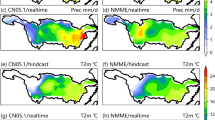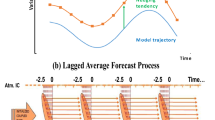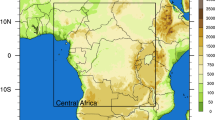Abstract
Multi-model ensemble prediction is an effective approach for improving the prediction skill short-term climate prediction and evaluating related uncertainties. Based on a combination of localized operation outputs of Chinese climate models and imported forecast data of some international operational models, the National Climate Center of the China Meteorological Administration has established the China multi-model ensemble prediction system version 1.0 (CMMEv1.0) for monthly-seasonal prediction of primary climate variability modes and climate elements. We verified the real-time forecasts of CMMEv1.0 for the 2018 flood season (June-August) starting from March 2018 and evaluated the 1991–2016 hindcasts of CMMEv1.0. The results show that CMMEv1.0 has a significantly high prediction skill for global sea surface temperature (SST) anomalies, especially for the El Niño-Southern Oscillation (EN-SO) in the tropical central-eastern Pacific. Additionally, its prediction skill for the North Atlantic SST triple (NAST) mode is high, but is relatively low for the Indian Ocean Dipole (IOD) mode. Moreover, CMMEv1.0 has high skills in predicting the western Pacific subtropical high (WPSH) and East Asian summer monsoon (EASM) in the June–July–August (JJA) season. The JJA air temperature in the CMMEv1.0 is predicted with a fairly high skill in most regions of China, while the JJA precipitation exhibits some skills only in northwestern and eastern China. For real-time forecasts in March–August 2018, CMMEv1.0 has accurately predicted the ENSO phase transition from cold to neutral in the tropical central-eastern Pacific and captures evolutions of the NAST and IOD indices in general. The system has also captured the main features of the summer WPSH and EASM indices in 2018, except that the predicted EASM is slightly weaker than the observed. Furthermore, CMMEv1.0 has also successfully predicted warmer air temperatures in northern China and captured the primary rainbelt over northern China, except that it predicted much more precipitation in the middle and lower reaches of the Yangtze River than observation.
Similar content being viewed by others
References
Ashok, K., Z. Y. Guan, and T. Yamagata, 2001: Impact of the Indian Ocean dipole on the relationship between the Indian monsoon rainfall and ENSO. Geophys. Res. Lett., 28, 4499–4502, DOI: https://doi.org/10.1029/2001GL013294.
Bao, Q., P. F. Lin, T. J. Zhou, et al., 2013: The flexible global ocean-atmosphere-land system model, spectral version 2: FGOALS-s2. Adv. Atmos. Sci., 30, 561–576, DOI: https://doi.org/10.1007/s00376-012-2113-9.
Bao, Q., X. F. Wu, J. X. Li, et al., 2019: Outlook for El Niño and the Indian Ocean Dipole in autumn–winter 2018–2019. Chinese Sei. Bull., 64, 73–78, DOI: https://doi.org/10.1360/N972018-00913. (in Chinese)
Becker, E., H. van den Dool, and Q. Zhang, 2014: Predictability and forecast skill in NMME. J. Climate, 27, 5891–5906, DOI: https://doi.org/10.1175/JCLI-D-13-00597.1.
Behringer, D. W., and Y. Xue, 2004: Evaluation of the Global Ocean Data Assimilation System at NCEP: The Pacific Ocean. Proceedings of the Eighth Symposium on Integrated Observing and Assimilation System for Atmosphere, Ocean, and Land Surface, AMS 84th Annual Meeting, Seattle, Washington, USA, 11–15.
Bengtsson, L., U. Schlese, E. Roeckner, et al., 1993: A two-tiered approach to long-range climate forecasting. Science, 261, 1026–1029, DOI: https://doi.org/10.1126/science.261.5124.1026.
Birkert, C., R. Murtugudde, and T. Allan, 1999: Indian Ocean climate event brings floods to East Africa’s lakes and the Sudd Marsh. Geophys. Res. Lett., 26, 1031–1034, DOI: https://doi.org/10.1029/1999GL900165.
Briegleb, B. P., C. M. Bitz, E. C. Hunke, et al., 2004: Scientific Description of the Sea Ice Component in the Community Climate System Model, Version 3. NCAR Tech Note NCAR/TN-463+ STR, NCAR, Boulder, CO, USA, 70 pp.
Buizza, R., T. Petroliagis, T. Palmer, et al., 1998: Impact of model resolution and ensemble size on the performance of an ensemble prediction system. Quart. J. Roy. Meteor. Soc., 124, 1935–1960, DOI: https://doi.org/10.1002/qj.49712455008.
Chen, W., 2002: Impacts of El Niño and La Nina on the cycle of the East Asian winter and summer monsoon. Chinese J. Atmos. Sci., 26, 595–610. (in Chinese)
Davey, M., M. Huddleston, K. Sperber, et al., 2002: STOIC: A study of coupled model climatology and variability in tropical ocean regions. Climate Dyn., 18, 403–420, DOI: https://doi.org/10.1007/s00382-001-0188-6.
Doblas-Reyes, F. J., R. Hagedorn, and T. N. Palmer, 2005: The rationale behind the success of multi-model ensembles in seasonal forecasting—II. Calibration and combination. Tellus A Dyn. Meteor. Oeeanogr., 57, 234–252, DOI: https://doi.org/10.3402/tellusa.v57i3.14658.
Feng, R., W. S. Duan, and M. Mu, 2014: The “winter predictability barrier” for IOD events and its error growth dynamics: Results from a fully coupled GCM. J. Geophys. Res. Oeeans, 119, 8688–8708, DOI: https://doi.org/10.1002/2014JC010473.
Fischer, A. S., P. Terray, E. Guilyardi, et al., 2005: Two independent triggers for the Indian Ocean dipole/zonal mode in a coupled GCM. J. Climate, 18, 3428–3449, DOI: https://doi.org/10.1175/JCLI3478.1.
Gitau, W., P. Camberlin, L. Ogallo, et al., 2015: Oceanic and atmospheric linkages with short rainfall season intraseasonal statistics over equatorial Eastern Africa and their predictive potential. Int. J. Climatol., 35, 23829–2399, DOI: https://doi.org/10.1002/joc.4131.
Hagedorn, R., F. J. Doblas-Reyes, and T. N. Palmer, 2005: The rationale behind the success of multi-model ensembles in seasonal forecasting—I. Basic concept. Tellus A Dyn. Meteor. Oceanogr., 57, 219–233, DOI: https://doi.org/10.3402/tellusa.v57i3.14657.
Holland, M. M., D. A. Bailey, B. P. Briegleb, et al., 2012: Improved sea ice shortwave radiation physics in CCSM4: The impact of melt ponds and aerosols on Arctic Sea ice. J. Climate, 25, 1413–1430, DOI: https://doi.org/10.1175/JCLI-D-11-00078.1.
Jia, X. L., L. J. Chen, Z. S. Gong, et al., 2011: Anomalies of ocean and atmospheric circulation in 2010 and their impacts on climate in China. Meteor. Mon., 37, 446–153. (in Chinese)
Jiang, X. W., S. Yang, Y. Q. Li, et al., 2013a: Seasonal-to-interannual prediction of the Asian summer monsoon in the NCEP climate forecast system version 2. J. Climate, 26, 3708–3727, DOI: https://doi.org/10.1175/JCLI-D-12-00437.1.
Jiang, X. W., S. Yang, J. P. Li, et al., 2013b: Variability of the Indian Ocean SST and its possible impact on summer western North Pacific anticyclone in the NCEP climate forecast system. Climate Dyn., 41, 2199–2212, DOI: https://doi.org/10.1007/s00382-013-1934-2.
Kalnay, W., M. Kanamitsu, R. Kistler, et al., 1996: The NCEP/NCAR 40-year reanalysis project. Bull. Amer. Meteor. Soc., 77, 437–472, DOI: https://doi.org/10.1175/1520-0477(1996)2.0.CO;2.
Kirtman, B. P., and D. Min, 2009: Multimodel ensemble ENSO prediction with CCSM and CFS. Mon. Wea. Rev., 137, 2908–2930, DOI: https://doi.org/10.1175/2009MWR2672.1.
Kobayashi, S., Y. Ota, Y. Harada, et al., 2015: The JRA-55 reanalysis: General specifications and basic characteristics. J. Meteor. Soc. Japan, 93, 5–48.
Krishnamurti, T. N., C. M. Kishtawal, T. E. LaRow, et al., 1999: Improved weather and seasonal climate forecasts from multimodel superensemble. Science, 285, 1548–1550, DOI: https://doi.org/10.1126/science.285.5433.1548.
Kug, J. S., J. Y. Lee, and I. S. Kang, 2008: Systematic error correction of dynamical seasonal prediction of sea surface temperature using a stepwise pattern project method. Mon. Wea. Rev., 136, 3501–3512, DOI: https://doi.org/10.1175/2008MWR2272.1.
Latif, M., K. Sperber, J. Arblaster, et al., 2001: ENSIP: The El Nino simulation intercomparison project. Climate Dyn., 18, 255–276, DOI: https://doi.org/10.1007/s003820100174.
Lavers, D., L. F. Luo, and E. F. Wood, 2009: A multiple model assessment of seasonal climate forecast skill for applications. Geophys. Res. Lett., 36, L23711, DOI: https://doi.org/10.1029/2009GL041365.
Lawrence, D. M., K. W. Oleson, M. G. Flanner, et al., 2011: Parameterization improvements and functional and structural advances in version 4 of the Community Land Model. J. Adv. Model. Earth Syst., 3, M03001, DOI: https://doi.org/10.1029/2011MS00045.
Li, C. Y., 1990: Interaction between anomalous winter monsoon in East Asia and El Nino events. Adv. Atmos. Sci., 7, 36–46, DOI: https://doi.org/10.1007/BF02919166.
Li, S. L., W. A. Robinson, and S. L. Peng, 2003: Influence of the North Atlantic SST tripole on northwest African rainfall. J. Geophys. Res. Atmos., 108, 4594, DOI: https://doi.org/10.1029/2002JD003130.
Li, T., B. Wang, C. P. Chang, et al., 2003: A theory for the Indian Ocean dipole-zonal mode. J. Atmos. Sci., 60, 2119–2135, DOI: https://doi.org/10.1175/1520-0469(2003)0602.0.CO;2.
Liu, H. L., Y. Q. Yu, W. Li, et al., 2004: Manual for LASG/IAP Climate System Ocean Model (LICOM1.0). Science Press, Beijing, 128 pp. (in Chinese).
Liu, Y., and H.-L. Ren, 2017: Improving ENSO prediction in CFSv2 with an analogue-based correction method. Int. J. Climatol., 37, 5035–5046, DOI: https://doi.org/10.1002/joc.5142.
Liu, Y. Y., W. J. Li, W. X. Ai, et al., 2012: Reconstruction and application of the monthly western Pacific subtropical high indices. J. Appl. Meteor. Sci., 23, 414–423, DOI: https://doi.org/10.3969/j.issn.1001-7313.2012.04.004. (in Chinese)
Lu, B., H.-L. Ren, R. Eade, et al., 2018: Indian Ocean SST modes and their impacts as simulated in BCC_CSM1.1(m) and HadGEM3. Adv. Atmos. Sci., 35, 1035–1048, DOI: https://doi.org/10.1007/s00376-018-7279-3.
Luo, J. J., S. Masson, S. Behera, et al., 2007: Experimental forecasts of the Indian Ocean dipole using a coupled OAGCM. J. Climate, 20, 2178–2190, DOI: https://doi.org/10.1175/JCLI4132.1.
Ma, J. H., and H. J. Wang, 2014: Design and testing of a global climate prediction system based on a coupled climate model. Sci. China Earth Sci., 57, 2417–2427, DOI: https://doi.org/10.1007/s11430-014-4875-7.
Min, Y. M., V. N. Kryjov, and S. M. Oh, 2014: Assessment of AP-CC multimodel ensemble prediction in seasonal climate forecasting: Retrospective (1983–2003) and real-time forecasts (2008–2013). J. Geophys. Res. Atmos., 119, 12132–12150, DOI: https://doi.org/10.1002/2014JD022230.
Molteni, F., T. Stockdale, M. Alonso-Balmaseda, et al., 2011: The New ECMWF Seasonal Forecast System (System 4). ECMWF Technical Memorandum 656, ECMWF, Reading, UK, 49 pp, DOI: https://doi.org/10.21957/4nery093i.
Oleson, K. W., Y. Dai, G. Bonan, et al., 2004: Technical Description of the Community Land Model (CLM). NCAR/TN-461+STR, NCAR, Boulder, CO, USA, 173 pp, DOI: https://doi.org/10.5065/D6N877R0.
Oleson, K. W., D. M. Lawrence, G. B. Bonan, et al., 2010: Technical Description of Version 4.0 of the Community Land Model (CLM). NCAR Technical Note NCAR/TN-478+STR, NCAR, Boulder, CO, USA, 257 pp, DOI: https://doi.org/10.5065/D6FB50WZ.
Palmer, T. N., Č. Branković, and D. S. Richardson, 2000: A probability and decision-model analysis of PROVOST seasonal multi-model ensemble integrations. Quart. J. Roy. Meteor. Soc., 126, 2013–2033, DOI: https://doi.org/10.1002/qj.49712656703.
Peng, P. T., A. Kumar, H. van den Dool, et al., 2002: An analysis of multimodel ensemble predictions for seasonal climate anomalies. J. Geophys. Res. Atmos., 107, 4710, DOI: https://doi.org/10.1029/2002JD002712.
Ren, H. L., and J. F. Chou, 2006: Analogue correction method of errors by combining statistical and dynamical methods. Acta Meteor. Sinica., 20, 367–373.
Ren, H. L., and J. F. Chou, 2007: Strategy and methodology of dynamical analogue prediction. Sci. China Earth Sci., 50, 1589–1599, DOI: https://doi.org/10.1007/s11430-007-0109-6.
Ren, H.-L., and F.-F. Jin, 2011: Niño indices for two types of ENSO. Geophys. Res. Lett., 38, L04704, DOI: https://doi.org/10.1029/2010GL046031.
Ren, H.-L., and F.-F. Jin, 2013: Recharge oscillator mechanisms in two types of ENSO. J. Climate, 26, 6506–6523, DOI: https://doi.org/10.1175/JCLI-D-12-00601.1.
Ren, H.-L., F.-F. Jin, B. Tian, et al., 2016: Distinct persistence barriers in two types of ENSO. Geophys. Res. Lett., 43, 10973–10979, DOI: https://doi.org/10.1002/2016GL071015.
Ren, H.-L., F.-F. Jin, L. C. Song, et al., 2017: Prediction of primary climate variability modes at the Beijing Climate Center. J. Meteor. Res., 31, 204–223, DOI: https://doi.org/10.1007/s13351-017-6097-3.
Ren, H.-L., B. Lu, J. H. Wan, et al., 2018: Identification standard for ENSO events and its application to climate monitoring and prediction in China. J. Meteor. Res., 32, 923–936, DOI: https://doi.org/10.1007/s13351-018-8078-6.
Ren, H.-L., A. A. Scaife, N. Dunstone, et al., 2019a: Seasonal predictability of winter ENSO types in operational dynamical model predictions. Climate Dyn., 3869–3890, DOI: https://doi.org/10.1007/s00382-018-4366-1.
Ren, H.-L., J. Q. Zuo, and Y. Deng, 2019b: Statistical predictability of Niño indices for two types of ENSO. Climate Dyn., 5361–5382, DOI: https://doi.org/10.1007/s00382-018-4453-3.
Reynolds, R. W., T. M. Smith, C. Y. Liu, et al., 2007: Daily high-resolution-blended analyses for sea surface temperature. J. Climate, 20, 5473–5496, DOI: https://doi.org/10.1175/2007JCLI1824.1.
Saha, S., S. Nadiga, C. Thiaw, et al., 2006: The NCEP climate forecast system. J. Climate, 19, 3483–3517, DOI: https://doi.org/10.1175/JCLI3812.1.
Saha, S., S. Moorthi, X. R. Wu, et al., 2014: The NCEP climate forecast system version 2. J. Climate, 27, 2185–2208, DOI: https://doi.org/10.1175/JCLI-D-12-00823.1.
Saji, N. H., and T. Yamagata, 2003: Possible impacts of Indian Ocean dipole mode events on global climate. Climate Res., 25, 151–169, DOI: https://doi.org/10.3354/cr025151.
Saji, N. H., B. N. Goswami, P. N. Vinayachandran, et al., 1999: A dipole mode in the tropical Indian Ocean. Nature, 401, 360–363, DOI: https://doi.org/10.1038/43854.
Schneider, E. K., B. P. Kirtman, D. G. DeWitt, et al., 2003: Retrospective ENSO forecasts: Sensitivity to atmospheric model and ocean resolution. Mon. Wea. Rev., 131, 3038–3060, DOI: https://doi.org/10.1175/1520-0493(2003)1312.0.CO;2.
Shi, L., H. H. Hendon, O. Alves, et al., 2012: How predictable is the Indian Ocean dipole? Mon. Wea. Rev., 140, 3867–3884, DOI: https://doi.org/10.1175/MWR-D-12-00001.1.
Tan, G. R., H.-L. Ren, H. S. Chen, et al., 2017: Detecting primary precursors of January surface air temperature anomalies in China. J. Meteor. Res., 31, 1096–1108, DOI: https://doi.org/10.1007/s13351-017-7013-6.
Teixeira, J., and C. A. Reynolds, 2008: Stochastic nature of physical parameterizations in ensemble prediction: A stochastic convection approach. Mon. Wea. Rev., 136, 483–496, DOI: https://doi.org/10.1175/2007MWR1870.1.
Wajsowicz, R. C., 2005: Potential predictability of tropical Indian Ocean SST anomalies. Geophys. Res. Lett., 32, L24702, DOI: https://doi.org/10.1029/2005GL024169.
Wang, B., R. G. Wu, and X. H. Fu, 2000: Pacific-East Asian tele-connection: How does ENSO affect east Asian climate? J. Climate, 13, 1517–1536, DOI: https://doi.org/10.1175/1520-0442(2000)0132.0.CO;2.
Wang, B., J.-Y. Lee, I.-S. Kang, et al., 2009: Advance and prospectus of seasonal prediction: Assessment of the APCC/CliPAS 14-model ensemble retrospective seasonal prediction (1980–2004). Climate Dyn., 33, 93–117, DOI: https://doi.org/10.1007/s00382-008-0460-0.
Wang, H. J., K. Fan, J. Q. Sun, et al., 2015: A review of seasonal climate prediction research in China. Adv. Atmos. Sei., 32, 149–168, DOI: https://doi.org/10.1007/s00376-014-0016-7.
Weisheimer, A., F. J. Doblas-Reyes, T. N. Palmer, et al., 2009: ENSEMBLES: A new multi-model ensemble for seasonal-to-annual predictions—Skill and progress beyond DEMETER in forecasting tropical Pacific SSTs. Geophys. Res. Lett., 36, L21711, DOI: https://doi.org/10.1029/2009GL040896.
Weng, H. Y., K. Ashok, S. K. Behera, et al., 2007: Impacts of recent El Niño Modoki on dry/wet conditions in the Pacific Rim during boreal summer. Climate Dyn., 29, 113–129, DOI: https://doi.org/10.1007/s00382-007-0234-0.
Weng, H. Y., S. K. Behera, and T. Yamagata, 2009: Anomalous winter climate conditions in the Pacific Rim during recent El Niño Modoki and El Niño events. Climate Dyn., 32, 663–674, DOI: https://doi.org/10.1007/s00382-008-0394-6.
Wu, G. X., J. F. Chou, Y. M. Liu, et al., 2002: Dynamics of the Formation and Variation of Subtropical Anticyclones. Science Press, Beijing, 314 pp. (in Chinese)
Wu, T. W., L. C. Song, W. P. Li, et al., 2014: An overview of BCC climate system model development and application for climate change studies. J. Meteor. Res., 28, 34–56, DOI: https://doi.org/10.1007/s13351-014-3041-7.
Xie, P. P., and P. A. Arkin, 1997: Global precipitation: A 17-year monthly analysis based on gauge observations, satellite estimates, and numerical model outputs. Bull. Amer. Meteor. Soc., 78, 2539–2558, DOI: https://doi.org/10.1175/1520-0477(1977)0782.0.CO;2.
Yang, S., Z. Q. Zhang, V. E. Kousky, et al., 2008: Simulations and seasonal prediction of the Asian summer monsoon in the NCEP Climate Forecast System. J. Climate, 21, 3755–3775, DOI: https://doi.org/10.1175/2008JCLI1961.1.
Yang, X., Z. Y. Guan, and B. L. Zhu, 2007: Role of Indian Ocean dipole events in the influence of ENSO on the summer rainfall and temperature in China. J. Nanjing Inst. Meteor., 30, 170–177, DOI: https://doi.org/10.3969/j.issn.1674-7097.2007.02.004. (in Chinese)
Yuan, Y., and S. Yang, 2012: Impacts of different types of El Niño on the East Asian climate: Focus on ENSO cycles. J. Climate, 25, 7702–7722, DOI: https://doi.org/10.1175/JCLI-D-11-00576.1.
Zhang, Q. Y., S. Y. Tao, and L. T. Chen, 2003: The interannual variability of East Asian summer monsoon indices and its association with the pattern of general circulation over East Asia. Acta Meteor. Sinica, 61, 559–568, DOI: https://doi.org/10.11676/qxxb2003.056. (in Chinese)
Zhang, R. H., A. Sumi, and M. Kimoto, 1996: Impact of El Niño on the East Asian monsoon: A diagnostic study of the ‘86/87 and ‘91/92 events. J. Meteor. Soc. Japan, 74, 49–62, DOI: https://doi.org/10.2151/jmsj1965.74.1_49.
Zhang, W. J., F.-F. Jin, J. P. Li, et al., 2011: Contrasting impacts of two-type El Niño over the western North Pacific during boreal autumn. J. Meteor. Soc. Japan, 89, 563–569, DOI: https://doi.org/10.2151/jmsj.2011-510.
Zhang, W. J., F.-F. Jin, H.-L. Ren, et al., 2012: Differences in tele-connection over the North Pacific and rainfall shift over the USA associated with two types of El Niño during boreal autumn. J. Meteor. Soc. Japan, 90, 535–552, DOI: https://doi.org/10.2151/jmsj.2012-407.
Zuo, J. Q., W. J. Li, C. H. Sun, et al., 2013: Impact of the North Atlantic sea surface temperature tripole on the East Asian summer monsoon. Adv. Atmos. Sci., 30, 1173–1186, DOI: https://doi.org/10.1007/s00376-012-2125-5.
Acknowledgments
The authors are grateful to the three anonymous reviewers for their insightful comments, which have helped improve the quality of the paper.
Author information
Authors and Affiliations
Corresponding author
Additional information
Supported by the National Key Research and Development Program of China (2017YFC1502306, 2017YFC1502302, and 2018YFC1506004) and China Meteorological Administration Special Project for Developing Key Techniques for Operational Meteorological Forecast (YBGJXM201805).
Rights and permissions
About this article
Cite this article
Ren, HL., Wu, Y., Bao, Q. et al. The China Multi-Model Ensemble Prediction System and Its Application to Flood-Season Prediction in 2018. J Meteorol Res 33, 540–552 (2019). https://doi.org/10.1007/s13351-019-8154-6
Received:
Accepted:
Published:
Issue Date:
DOI: https://doi.org/10.1007/s13351-019-8154-6




